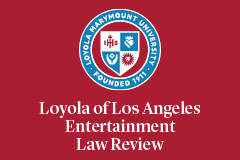Abstract
The typical case of alleged trademark infringement, i.e., “forward confusion,” involves a larger and more established “senior user” and a smaller and less powerful “junior user.” The secondary junior user wrongfully uses the first senior user’s mark as its own, and thus benefits from the senior user’s more established goodwill. In ruling on a senior user’s trademark infringement claim, the court will use a set of “likelihood of confusion” factors to determine if consumers are confusing the junior user’s goods for that of the senior. Each circuit’s factors vary, but they are harmonious. The issue that this Note explores is the difficult and counterintuitive doctrine of reverse confusion.
Reverse confusion occurs when the junior user of a mark is larger and more powerful than the senior user. As the stronger secondary entity, the junior user is able to flood the market with advertisements about its good or service, and consumers purchase the senior user’s product upon the mistaken belief that it is that of the junior user.
At first, courts did not see the harm in reverse confusion. The less reputable senior user reaps a profit after all—what is the problem? The problem is that the senior user has spent time and money in branding its goods or services with a mark that the senior user wants to indicate as its source. When a powerful junior user adopts that mark, consumers believe that the mark indicates the junior user as the source of the goods, rather than the true smaller entity. This confusion harms the senior user’s goodwill and reputation.
Although all federal courts now recognize the doctrine of reverse confusion and the harm it imposes, this Note describes how far the courts have come and how far they still have yet to go. There is no coherent test, and the likelihood of confusion analysis in forward confusion does not outright apply in reverse confusion cases due to the inverse power relationship between the parties. Because the senior user is the weaker entity in a reverse confusion case, certain likelihood of confusion factors should be analyzed differently to take this into account. For example, in a typical forward confusion case the court considers the inherent and commercial strength of the senior user’s mark. The stronger the mark, the greater the likelihood of confusion. If this analysis were to directly apply in reverse confusion, where the junior user is by definition the stronger entity, every senior user would lose on the strength of the mark factor. Therefore, the analysis in reverse confusion should be changed to consider the strength of the junior user’s mark and its relative likelihood of confusion. Discreet, but consequential, modifications such as this will correct the likelihood of confusion analysis to ensure a consistent and just result in reverse confusion cases. Furthermore, this Note posits that legislative action is needed to statutorily define a uniform test.
Part I of this Note introduces the problematic realm of reverse confusion faced by the courts. Part II begins with the public policies underlying trademark law and explains a viable trademark infringement claim under the Lanham Act. Part III addresses consumer confusion in both the traditional forward confusion cases and reverse confusion cases. Additionally, Part III also discusses the inherent confusion and lack of clarity caused by inconsistent circuit court approaches. Part IV argues why reverse confusion is an important, separate, actionable claim. Lastly, Part V concludes that legislative action is needed to dispel the confusion regarding reverse confusion in the courts and sets forth the principles to adopt in amending the Lanham Act.
Recommended Citation
Inna Kaminer,
Set the Statutes Straight: Amending the Lanham Act to Dispel the Confusion Regarding Reverse Confusion,
36 Loy. L.A. Ent. L. Rev. 71
(2015).
Available at: https://digitalcommons.lmu.edu/elr/vol36/iss1/3


